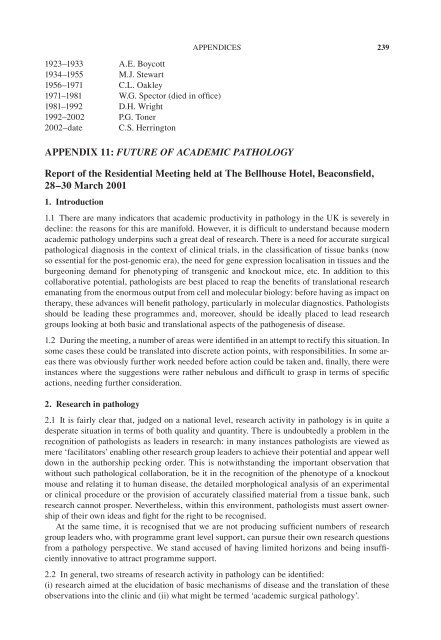Historical data are presented in numerous appendicies - The ...
Historical data are presented in numerous appendicies - The ...
Historical data are presented in numerous appendicies - The ...
You also want an ePaper? Increase the reach of your titles
YUMPU automatically turns print PDFs into web optimized ePapers that Google loves.
1923–1933 A.E. Boycott<br />
1934–1955 M.J. Stewart<br />
1956–1971 C.L. Oakley<br />
1971–1981 W.G. Spector (died <strong>in</strong> office)<br />
1981–1992 D.H. Wright<br />
1992–2002 P.G. Toner<br />
2002–date C.S. Herr<strong>in</strong>gton<br />
APPENDICES 239<br />
APPENDIX 11: FUTURE OF ACADEMIC PATHOLOGY<br />
Report of the Residential Meet<strong>in</strong>g held at <strong>The</strong> Bellhouse Hotel, Beaconsfield,<br />
28–30 March 2001<br />
1. Introduction<br />
1.1 <strong>The</strong>re <strong>are</strong> many <strong>in</strong>dicators that academic productivity <strong>in</strong> pathology <strong>in</strong> the UK is severely <strong>in</strong><br />
decl<strong>in</strong>e: the reasons for this <strong>are</strong> manifold. However, it is difficult to understand because modern<br />
academic pathology underp<strong>in</strong>s such a great deal of research. <strong>The</strong>re is a need for accurate surgical<br />
pathological diagnosis <strong>in</strong> the context of cl<strong>in</strong>ical trials, <strong>in</strong> the classification of tissue banks (now<br />
so essential for the post-genomic era), the need for gene expression localisation <strong>in</strong> tissues and the<br />
burgeon<strong>in</strong>g demand for phenotyp<strong>in</strong>g of transgenic and knockout mice, etc. In addition to this<br />
collaborative potential, pathologists <strong>are</strong> best placed to reap the benefits of translational research<br />
emanat<strong>in</strong>g from the enormous output from cell and molecular biology: before hav<strong>in</strong>g as impact on<br />
therapy, these advances will benefit pathology, particularly <strong>in</strong> molecular diagnostics. Pathologists<br />
should be lead<strong>in</strong>g these programmes and, moreover, should be ideally placed to lead research<br />
groups look<strong>in</strong>g at both basic and translational aspects of the pathogenesis of disease.<br />
1.2 Dur<strong>in</strong>g the meet<strong>in</strong>g, a number of <strong>are</strong>as were identified <strong>in</strong> an attempt to rectify this situation. In<br />
some cases these could be translated <strong>in</strong>to discrete action po<strong>in</strong>ts, with responsibilities. In some <strong>are</strong>as<br />
there was obviously further work needed before action could be taken and, f<strong>in</strong>ally, there were<br />
<strong>in</strong>stances where the suggestions were rather nebulous and difficult to grasp <strong>in</strong> terms of specific<br />
actions, need<strong>in</strong>g further consideration.<br />
2. Research <strong>in</strong> pathology<br />
2.1 It is fairly clear that, judged on a national level, research activity <strong>in</strong> pathology is <strong>in</strong> quite a<br />
desperate situation <strong>in</strong> terms of both quality and quantity. <strong>The</strong>re is undoubtedly a problem <strong>in</strong> the<br />
recognition of pathologists as leaders <strong>in</strong> research: <strong>in</strong> many <strong>in</strong>stances pathologists <strong>are</strong> viewed as<br />
mere ‘facilitators’ enabl<strong>in</strong>g other research group leaders to achieve their potential and appear well<br />
down <strong>in</strong> the authorship peck<strong>in</strong>g order. This is notwithstand<strong>in</strong>g the important observation that<br />
without such pathological collaboration, be it <strong>in</strong> the recognition of the phenotype of a knockout<br />
mouse and relat<strong>in</strong>g it to human disease, the detailed morphological analysis of an experimental<br />
or cl<strong>in</strong>ical procedure or the provision of accurately classified material from a tissue bank, such<br />
research cannot prosper. Nevertheless, with<strong>in</strong> this environment, pathologists must assert ownership<br />
of their own ideas and fight for the right to be recognised.<br />
At the same time, it is recognised that we <strong>are</strong> not produc<strong>in</strong>g sufficient numbers of research<br />
group leaders who, with programme grant level support, can pursue their own research questions<br />
from a pathology perspective. We stand accused of hav<strong>in</strong>g limited horizons and be<strong>in</strong>g <strong>in</strong>sufficiently<br />
<strong>in</strong>novative to attract programme support.<br />
2.2 In general, two streams of research activity <strong>in</strong> pathology can be identified:<br />
(i) research aimed at the elucidation of basic mechanisms of disease and the translation of these<br />
observations <strong>in</strong>to the cl<strong>in</strong>ic and (ii) what might be termed ‘academic surgical pathology’.













